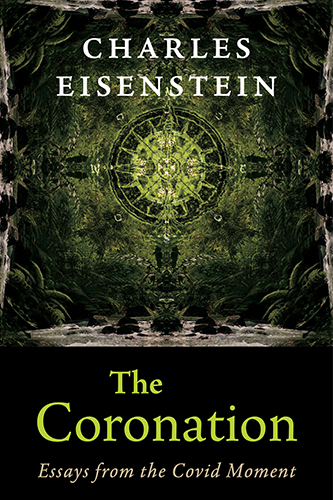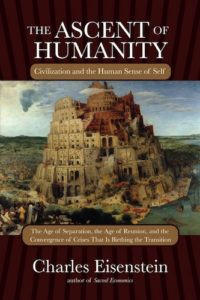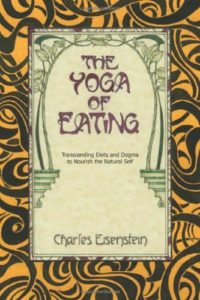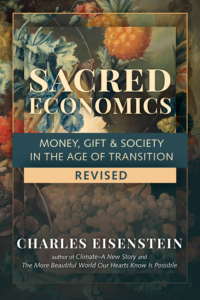The More Beautiful World Our Hearts Know Is Possible
Chapters
Chapter 2: Breakdown
The kingdom of God is for the broken hearted.
―Fred Rogers
It is frightening, this transition between worlds, but it is also alluring. Have you ever gotten addicted to doom-and-gloom websites, logging on every day to read the latest evidence that collapse is coming soon, feeling almost let down when Peak Oil didn’t start in 2005, or the financial system didn’t collapse in 2008? (I’m still worried about Y2K myself.) Do you look toward the future with a mixture of dread, yes, but also a kind of positive anticipation? When a big crisis looms, a superstorm or financial crisis, is there a part of you that says, “Bring it on!” hoping it might free us from our collective entrapment in a system that serves no one (not even its elites)?
It is quite normal to fear what one most desires. We desire to transcend the Story of the World that has come to enslave us, that indeed is killing the planet. We fear what the end of that story will bring: the demise of much that is familiar.
Fear it or not, it is happening already. Since my childhood in the 1970s, our Story of the People has eroded at an accelerating rate. More and more people in the West no longer believe that civilization is fundamentally on the right track. Even those who don’t yet question its basic premises in any explicit way seem to have grown weary of it. A layer of cynicism, a hipster self-awareness has muted our earnestness. What was once so real, say a plank in a party platform, today is seen through several levels of “meta” filters that parse it in terms of image and message. We are like children who have grown out of a story that once enthralled us, aware now that it is only a story.
At the same time, a series of new data points has disrupted the story from the outside. The harnessing of fossil fuels, the miracle of chemicals to transform agriculture, the methods of social engineering and political science to create a more rational and just society—each has fallen far short of its promise, and brought unanticipated consequences that, together, threaten civilization. We just cannot believe anymore that the scientists have everything well in hand. Nor can we believe that the onward march of reason will bring on social Utopia.
Today we cannot ignore the intensifying degradation of the biosphere, the malaise of the economic system, the decline in human health, or the persistence and indeed growth of global poverty and inequality. We once thought economists would fix poverty, political scientists would fix social injustice, chemists and biologists would fix environmental problems, the power of reason would prevail and we would adopt sane policies. I remember looking at maps of rainforest decline in National Geographic in the early 1980s and feeling both alarm and relief—relief because at least the scientists and everyone who reads National Geographic are aware of the problem now, so something surely will be done.
Nothing was done. Rainforest decline accelerated, along with nearly every other environmental threat that we knew about in 1980. Our Story of the People trundled forward under the momentum of centuries, but with each passing decade the hollowing-out of its core, which started perhaps with the industrial-scale slaughter of World War I, extended further. When I was a child, our ideological systems and mass media still protected that story, but in the last thirty years the incursions of reality have punctured its protective shell and eroded its essential infrastructure. We no longer believe our storytellers, our elites.
We have lost the vision of the future we once had; most people have no vision of the future at all. This is new for our society. Fifty or a hundred years ago, most people agreed on the general outlines of the future. We thought we knew where society was going. Even the Marxists and the capitalists agreed on its basic outlines: a paradise of mechanized leisure and scientifically engineered social harmony, with spirituality either abolished entirely or relegated to a materially inconsequential corner of life that happened mostly on Sundays. Of course there were dissenters from this vision, but this was the general consensus.
Like an animal, when a story nears its end it goes through death throes, an exaggerated semblance of life. So today we see domination, conquest, violence, and separation take on absurd extremes that hold a mirror up to what was once hidden and diffuse. Here are a few examples:
Villages in Bangladesh where half the people have just one kidney, having sold the other in the black-market organ trade. Usually this is done to pay off debts. Here we see, literalized, the conversion of life into money that drives our economic system.
Prisons in China where prisoners must spend fourteen hours a day playing online video games to build up character experience points. The prison officials then sell these characters to teenagers in the West. Here we see, in extreme form, the disconnect between the physical and virtual worlds, the suffering and exploitation upon which our fantasies are built.
Old people in Japan whose relatives have no time to see them, so instead they receive visits from professional “relatives” who pretend to be family members. Here is a mirror to the dissolution of the bonds of community and family, to be replaced by money.
Of course, all of these pale in comparison to the litany of horrors that punctuates history and continues, endemic, to this day. The wars, the genocide, the mass rapes, the sweatshops, the mines, the slavery. On close examination, these are no less absurd. It is the height of absurdity that we are still manufacturing hydrogen bombs and depleted uranium munitions at a time when the planet is in such peril that we all must pull together, and soon, for civilization to have any hope of standing. The absurdity of war has never escaped the most perceptive among us, but in general we have had narratives that obscure or normalize that absurdity, and thus protect the Story of the World from disruption.
Occasionally, something happens that is so absurd, so awful, or so manifestly unjust that it penetrates these defenses and causes people to question much of what they’d taken for granted. Such events present a cultural crisis. Typically, though, the dominant mythology soon recovers, incorporating the event back into its own narratives. The Ethiopian famine became about helping those poor black children unfortunate enough to live in a country that still hasn’t “developed” as we have. The Rwandan genocide became about African savagery and the need for humanitarian intervention. The Nazi Holocaust became about evil taking over, and the necessity to stop it. All of these interpretations contribute, in various ways, to the old Story of the People: we are developing, civilization is on the right track, goodness comes through control. None hold up to scrutiny; they obscure, in the former two examples, the colonial and economic causes of the famine and genocide, which are still ongoing. In the case of the Holocaust, the explanation of evil obscures the mass participation of ordinary people—people like you and me. Underneath the narratives a disquiet persists, the feeling that something is terribly wrong with the world.
The year 2012 ended with a small but potent story-piercing event: the Sandy Hook massacre. By the numbers, it was a small tragedy: far more, and equally innocent, children died in U.S. drone strikes that year, or by hunger that week, than died at Sandy Hook. But Sandy Hook penetrated the defense mechanisms we use to maintain the fiction that the world is basically okay. No narrative could contain its utter senselessness and quell the realization of a deep and awful wrongness.
We couldn’t help but map those murdered innocents onto the young faces we know, and the anguish of their parents onto ourselves. For a moment, I imagine, we all felt the exact same thing. We were in touch with the simplicity of love and grief, a truth outside of story.
Following that moment, people hurried to make sense of the event, subsuming it within a narrative about gun control, mental health, or the security of school buildings. No one believes deep down that these responses touch the heart of the matter. Sandy Hook is an anomalous data point that unravels the entire narrative—the world no longer makes sense. We struggle to explain what it means, but no explanation suffices. We may go on pretending that normal is still normal, but this is one of a series of “end time” events that is dismantling our culture’s mythology.
Who could have foreseen, two generations ago when the story of progress was strong, that the twenty-first century would be a time of school massacres, of rampant obesity, of growing indebtedness, of pervasive insecurity, of intensifying concentration of wealth, of unabated world hunger, and of environmental degradation that threatens civilization? The world was supposed to be getting better. We were supposed to be becoming wealthier, more enlightened. Society was supposed to be advancing. Is heightened security the best we can aspire to? What happened to visions of a society without locks, without poverty, without war? Are these things beyond our technological capacities? Why are the visions of a more beautiful world that seemed so close in the middle twentieth century now seem so unreachable that all we can hope for is to survive in an ever more competitive, ever more degraded world? Truly, our stories have failed us. Is it too much to ask, to live in a world where our human gifts go toward the benefit of all? Where our daily activities contribute to the healing of the biosphere and the well-being of other people? We need a Story of the People—a real one, that doesn’t feel like a fantasy—in which a more beautiful world is once again possible.
Various visionary thinkers have offered versions of such a story, but none has yet become a true Story of the People, a widely accepted set of agreements and narratives that gives meaning to the world and coordinates human activity toward its fulfillment. We are not quite ready for such a story yet, because the old one, though in tatters, still has large swaths of its fabric intact. And even when these unravel, we still must traverse, naked, the space between stories. In the turbulent times ahead our familiar ways of acting, thinking, and being will no longer make sense. We won’t know what is happening, what it all means, and, sometimes, even what is real. Some people have entered that time already.
I wish I could tell you that I am ready for a new Story of the People, but even though I am among its many weavers, I cannot yet fully inhabit the new vestments. As I describe the world that could be, something inside me doubts and rejects, and underneath the doubt is a hurting thing. The breakdown of the old story is kind of a healing process that uncovers the old wounds hidden under its fabric and exposes them to the healing light of awareness. I am sure many people reading this have gone through such a time, when the cloaking illusions fell away: all the old justifications and rationalizations, all the old stories. Events like Sandy Hook help to initiate the very same process on a collective level. So also the superstorms, the economic crisis, political meltdowns … in one way or another, the obsolescence of our old mythology is laid bare.
What is that hurting thing, that takes the form of cynicism, despair, or hate? Left unhealed, can we hope that any future we create won’t reflect that wound back at us? How many revolutionaries have re-created, in their own organizations and countries, the very institutions of oppression they sought to overthrow? Only in the Story of Separation can we insulate outside from inside. As that story breaks down, we see that each necessarily reflects the other. We see the necessity of reuniting the long-sundered threads of spirituality and activism.
Bear in mind, as I describe the elements of a new Story of the People in the next chapter, that we have a rugged territory to traverse to get to it from where we are today. If my description of a Story of Interbeing, a reunion of humanity and nature, self and other, work and play, discipline and desire, matter and spirit, man and woman, money and gift, justice and compassion, and so many other polarities seems idealistic or naive, if it arouses cynicism, impatience, or despair, then please do not push these feelings aside. They are not obstacles to be overcome (that is part of the old Story of Control). They are gateways to our fully inhabiting a new story, and the vastly expanded power to serve change that it brings.
We do not have a new story yet. Each of us is aware of some of its threads, for example in most of the things we call alternative, holistic, or ecological today. Here and there we see patterns, designs, emerging parts of the fabric. But the new mythos has not yet formed. We will abide for a time in the “space between stories.” It is a very precious—some might say sacred—time. Then we are in touch with the real. Each disaster lays bare the reality underneath our stories. The terror of a child, the grief of a mother, the honesty of not knowing why. In such moments our dormant humanity awakens as we come to each other’s aid, human to human, and learn who we are. That’s what keeps happening every time there is a calamity, before the old beliefs, ideologies, and politics take over again. Now the calamities and contradictions are coming so fast that the story has not enough tine to recover. Such is the birth process into a new story.






